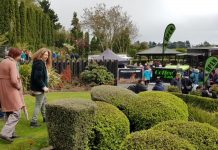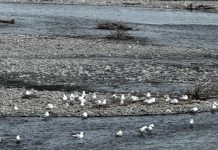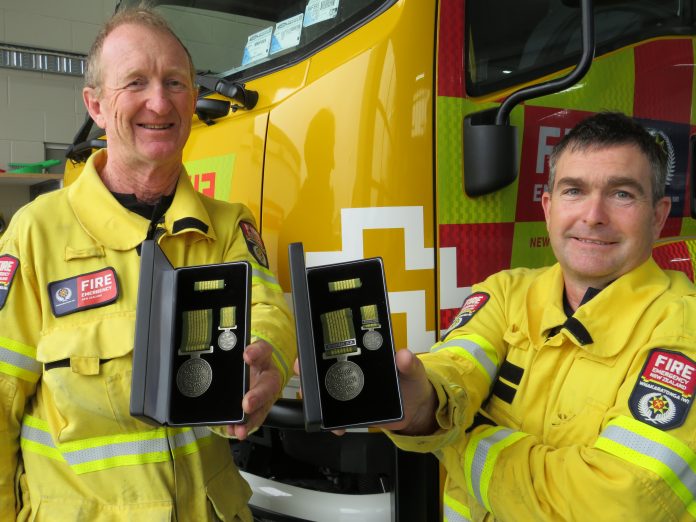
Mid Canterbury firefighters John Ferguson and Mark Shears were among five firefighters from the district this month to be honoured with an Australian National Emergency Medal.
They helped ‘‘shattered’’ Aussie firefighters in the summer of 2019/2020 deal with fast moving wild bushfires, which caused wide spread property and wildlife damage during weeks of burning.
It was a big operation, involving weeks of backbreaking firefighting work with the Kiwi contingent carrying out various operations.
Mr Shears, self-employed owner of seed processing business Proseed Processing, did one tour, while Mr Ferguson, employed by Fire and Emergency NZ, carried out two.
The Aussies, used to bushfires as an annual occurrence with weather patterns, appreciated the support.
‘‘We came home and they were still (fighting it),’’ Mr Shears said.
Mr Shears, chief fire officer at Lauriston Fire Station, said the area he was based was remote, hilly country and crews worked off road ways.
‘‘You were just in smoke the whole time, never saw the light of day,’’ Mr Shears said.
He stayed at Port McQuarry, based at Wauchop.
‘‘We went as a taskforce from New Zealand. There were five crews of four and we all worked together.’’
New Zealand crews took their own uniforms and helmets, but used spare fire trucks on site.
‘‘We were working around the the national park, up in that area,’’ he said, working from 10am to midnight, doing mostly back burning work.’’
The process was a big learning curve for the New Zealand crews.
It was a five days on, one day off, five days on roster, with a day for travel either side.
‘‘I think the whole time we were there we used 1000 litres of water,’’ Mr Shears said.
‘‘ … and a 1000 litres of diesel,’’ Mr Ferguson added.
Mr Ferguson, a FENZ volunteer support officer, volunteered twice, first as part of a taskforce team assigned to Laguna Fire Brigade, near Cessnock in New South Wales, and then aligned with the National Parks and Wildlife Service damping down hot spots in big forestry blocks.
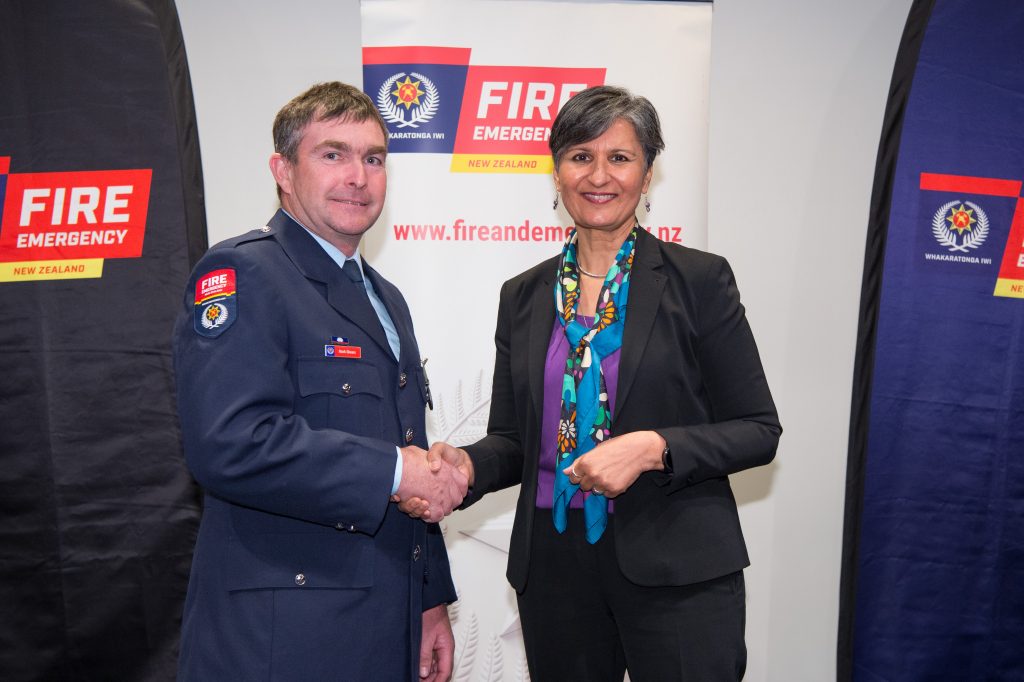
He said the job involved doing what was needed in each area.
‘‘We were (with Laguna) on property protection, mainly the first week just doing what we could, saving the saveable ones and bypassing the undefendable properties.’’
It all was a remote location, densely covered bushland.
‘‘We were going down tracks that were bush-lined, and then all of a sudden you see half a dozen houses.’’
Many of those houses, or bush huts, were owned by weekenders, people from Sydney who come up at the weekends and spend time in the bush, he said.
The landscape included hills and valleys with high burning dense bushlands.
Each stint saw firefighters being away for 13 days; one day travel, five days working, one day rest, before another five days back working and one day travel home.
It was a standard roster for crews heading across the ditch although in the US, where both men went to help with the California fires in 2018, crews did two weeks solid work.
You are switched on to help ‘‘as soon as you’re on the ground that’s it,’’ Mr Ferguson said.
‘‘We rocked in to (Laguna) fire brigade and these people, you could see it on their faces, they’d been fighting this fire for weeks and it’s their own area, it’s their own people, it’s their neighbours and they were just shattered.
‘‘And you look at them and you think ‘‘Holy hell, the bloody poor buggars, what can we do to help’’.’’
‘‘They were happy to see us.’’
The communities ‘‘welcomed us with open arms’’, with some going so far as to have a community whip around to take volunteers deep sea fishing on their one day off. Others went golfing.
The second week – and with extreme water shortages – Mr Ferguson said they started fighting fire with fire.
It was a huge learning curve.
‘‘We learned how to back burn basically, which New Zealand doesn’t do,’’ Mr Ferguson said.
‘‘We got introduced to drip torches and fuel so we were burning more than we were fighting … you take the fuel out of the equation by burning it as best they can. That’s the easiest way.’’
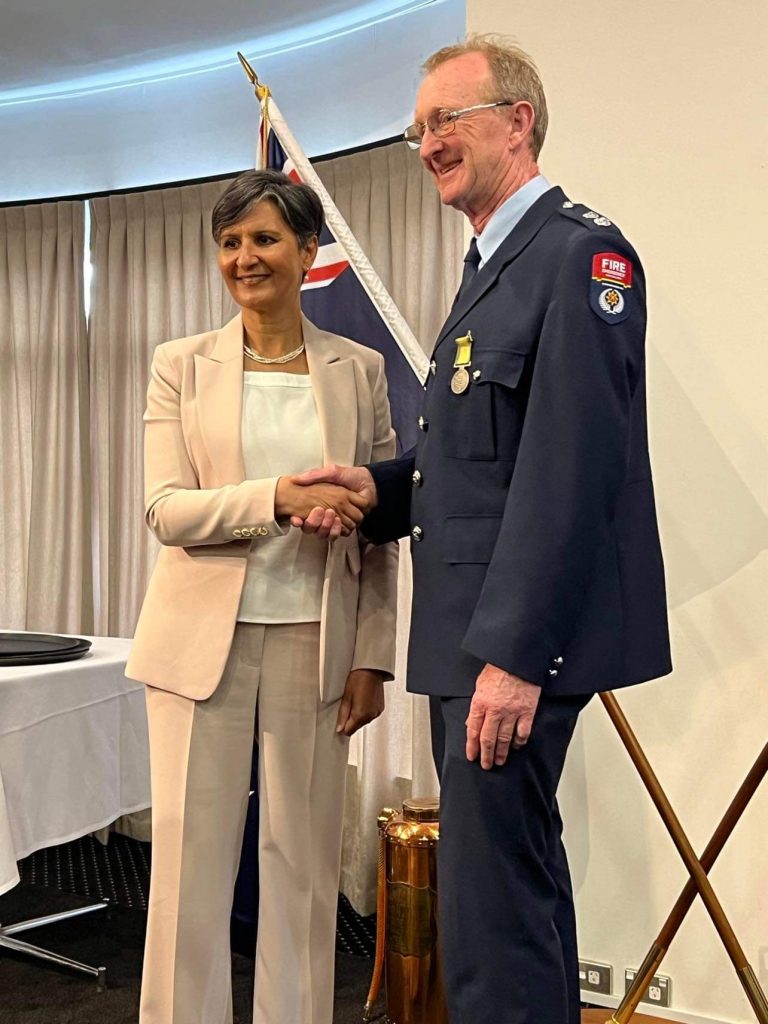
Mr Shears said once the New Zealand crews got their heads around it, it was simple.
‘‘I remember the first night we did it the joker in charge said ‘‘You Kiwi’s are mad, you’re going to start a bush fire… we were lighting too big an area.’’
Water – a ‘‘gold commodity’’ – was extremely scarce in the area, and sourced from localised farm dams.
‘‘We were allowed to use it, as long as it was replaced,’’ Mr Shears said.
Mr Ferguson said wild life preservation included damping down hot spots to prevent any possible flare ups and helping to relocate whatever animals they found along the way including Blue Tongue Lizards and snakes.
‘‘The fellow I was working with saw the third deadliest snake in all Australia … it’s funny, all the Aussies get out of the area, but the Kiwis are getting their phones out their pockets (to take photos).
‘‘The Kiwis wanted to see it but the Aussie’s didn’t,’’ he said.
Mr Ferguson’s second deployment, was as part of the remote area firefighting team (RAFT) and was done on foot in remote track access areas supporting Aussie fly in crews.
He received his award in an Auckland ceremony, while Mr Shears received his at Christchurch.
Both men were honoured to have received the medal in front of their peers, and especially their supportive family members who enabled them to carry out such firefighting duties.
Mr Shears had his wife Deb present, and Mr Ferguson with his wife Kathy and daughter Nicole.
The medal – with Bushfires 19/20 clasp – was presented to the majority of the New Zealand contingent of 208 firefighters who helped battle the Australian 2019/2020 bushfires by Australian High Commission Harinder Sidhu at four services nationwide.
The New Zealand contingent was made up of people from Fire and Emergency New Zealand, the Department of Conservation, forestry company partners and members of the New Zealand Defence Force.
Fire and Emergency NZ national commander Russell Wood said the Australia National Emergency Medal, for which service must be considered extraordinary, had never been awarded to members of Fire and Emergency NZ before.
‘‘This is a very rare and special honour that the Australian government has extended to us,’’ Mr Wood said.
‘‘It reflects that closeness between our countries, that when faced with extreme adversity, we will do everything we can to help eachother.
‘‘The bushfires in Australia in 2019 and 2020 were catastrophic, and we wereglad we could be there to help them.
‘‘I am immensely proud of our people, who responded to the call so selflessly and put their time and energy into fighting one of the biggest wildfire disasters of our time.
‘‘It was a dangerous environment for everyone to be in, and they showed true Kiwi spirit in their sustained efforts under challenging conditions. As a nation, we can be very proud of our fine firefighters.’’

